Exploring The Riviera Maya:
Sand, Sea, and Ruins on the Yucatan Coast
by Emilie C. Harting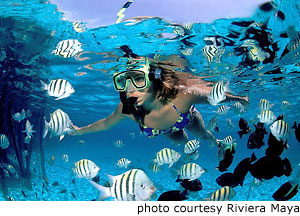 "How many?" I asked, as soon as I rose to surface and cleared my snorkel mask. "Ten, maybe fifteen," said my husband Rob.
"How many?" I asked, as soon as I rose to surface and cleared my snorkel mask. "Ten, maybe fifteen," said my husband Rob.
"Did you see the big stripped one, the sergeant major?"
"Uh- huh," he said, and we went back to bopping along the surface of the water and peering down to the coral reef.
The conversation went on back in the boat. Yes, sergeant majors, blue fish, parrot fish," our two adult children, Morgan and Thea, chimed in and we rattled off the species we had spotted. For the rest of the trip, ten to twenty seemed to be the fish count. Quite satisfactory for snorkelers!
We were exploring the Yucatan's Riviera Maya, the corridor of beach and rainforest that runs north and south on the Caribbean Sea, starting with the unspoiled fishing village of Puerto Morelos on the northern end, and running down to the major Mayan ruin, Tulum, at the south. On a map the Riviera is the sole of the boot that juts out to the right at the southern end of Mexico. For a week the four of us stayed at the Riu Palace Mexico at Playacar, a Spanish colonial style complex with five restaurants, located midway along the Riviera. We snorkeled, walked beaches, explored villages and significant Mayan ruins, visited eco-archeological parks and nature preserves, and enjoyed swimming, boating, and night life back at our hotel.
Though my husband and I usually gravitate toward smaller, more out-of-the way places, this time, with the interests of two generations in mind, we wanted to stay at a place that was within walking distance of a safe town for stores and nightlife, on a beach with good swimming and opportunities for water sports, and not far from ruins and rainforest activities. Our hotel at Playacar proved to be an excellent location for all that.
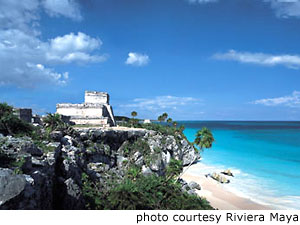 A highlight was the Sian Ká an Biopreserve, a remote area of jungle, marshes, and mangroves, where we sat on life preservers and floated down an ancient Mayan canal, built as a trade route to Tulum and other Central American trading centers. Over 300 species of birds live here, along with numerous turtles, crocodiles, jaguars and other animals. When we looked up over the tall grasses of the savannah and into the clouds, I could understand why the Mayans called this area, "Where the sky begins."
A highlight was the Sian Ká an Biopreserve, a remote area of jungle, marshes, and mangroves, where we sat on life preservers and floated down an ancient Mayan canal, built as a trade route to Tulum and other Central American trading centers. Over 300 species of birds live here, along with numerous turtles, crocodiles, jaguars and other animals. When we looked up over the tall grasses of the savannah and into the clouds, I could understand why the Mayans called this area, "Where the sky begins."
Nearby, we climbed through the ruins of the complex Mayan city Tulum, whose grand ceremonial temple sits on a forty-foot sea cliff. Many of the stone buildings have faded carvings of deities, such as the of god of wind and the god of honey.
In its heyday, from about 1000-1500 A.D., Tulum was a major trading center exporting honey and cocoa beans to other city-states. Now, when you look down the rocks to the shore where the first white men landed, visitors dip in and out of the sea on a sandy beach.
A sense of stillness reigns at Cobá, a ruin thirty miles northwest and spread over a wooded area with five lakes. An important interior trading center, Cobá was at one time considered the "sister city" of Tikal in Guatemala, and had five roads branching out into the Mayan world. We walked through shaded paths to the temples, and on to the main pyramid, Nohuch Mol. From the top we were able to look down into the forests of the Yucatan in many directions.
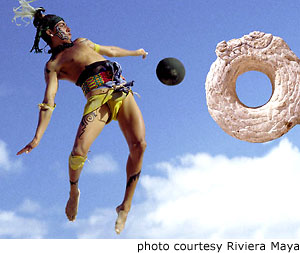 It was quite thrilling to find an intact Mayan ball court at Cobá, since other Mayan ruins we've visited had only a few stones left in the ground to mark the site where the athletic games of the town had taken place, and it was difficult to visualize a game. We walked through the the 12 foot wide flat channel where the players bounced the ball back and forth to each other, using their hips rather than arms or legs after the first kick. Spectators sat at the top of the stone bleachers, above the point where the ball hits the angled sides. Several days later, when we attended the Broadway quality musical of Mexican history at Xcaret, the postclassical period of Mayan sporting life came alive again. We sat high up on seats in a theater that had been built in the shape of an ancient ball court, and watched a fierce game.
It was quite thrilling to find an intact Mayan ball court at Cobá, since other Mayan ruins we've visited had only a few stones left in the ground to mark the site where the athletic games of the town had taken place, and it was difficult to visualize a game. We walked through the the 12 foot wide flat channel where the players bounced the ball back and forth to each other, using their hips rather than arms or legs after the first kick. Spectators sat at the top of the stone bleachers, above the point where the ball hits the angled sides. Several days later, when we attended the Broadway quality musical of Mexican history at Xcaret, the postclassical period of Mayan sporting life came alive again. We sat high up on seats in a theater that had been built in the shape of an ancient ball court, and watched a fierce game.
Xel-Ha, meaning "where water is born," is a eco-archeological park with a series of forested paths around a natural rocky inlet where freshwater springs and underground rivers flow into the ocean. We took a route through a nursery shaded by high trees, learned which trees and plants are used for medicinal purposes and, on the way, peered down into cenotes, cave openings, where snorkelers were swimming though an underground river. After floating down an open river on tubes from the top of the forest to the inlet, we walked through the woods to the point where the water flows over rock formations and rolls out into the sea. The intense sounds of birds and lapping waves made it seem as if we were on a private island, and the view from the lighthouse on the rocky edge of the Caribbean Sea was quite moving.
"I want to spend the winter there someday," my friends keep hearing me say when I describe Puerto Morelos, the Riviera's northern gateway. It is one of those heavenly unspoiled fishing villages with a town square, a few side streets with cafes and shops, and wide, calm, sparsely populated beaches. Some of the best snorkeling and diving on the Riviera Maya is just 1800 feet offshore.
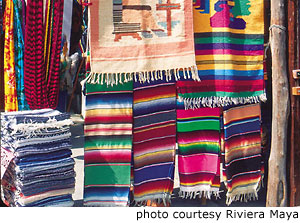 Since protected mangroves surround the town, development has been slower here, and the luxury hotels stand away from the center and blend into the landscape. Puerto Morelos has a population of 2800, many of them expats and Canadians who come down for the winter. The bookstore and the large cooperative where local Mayan artists -- hammock makers, jewelry makers, and weavers, and others, demonstrate their craft -- is a draw for vacationers staying in other areas of the Yucatan.
Since protected mangroves surround the town, development has been slower here, and the luxury hotels stand away from the center and blend into the landscape. Puerto Morelos has a population of 2800, many of them expats and Canadians who come down for the winter. The bookstore and the large cooperative where local Mayan artists -- hammock makers, jewelry makers, and weavers, and others, demonstrate their craft -- is a draw for vacationers staying in other areas of the Yucatan.
"It's quiet here ALL year round. That's why I love it so much," said the operator of a local fishing and diving company who had moved here from northern Mexico.
If we had done nothing but stayed at our hotel, The Riu Palace Mexico, we still would have had an excellent vacation with a balance of leisure time and activity. "I really loved being in a place with so much to do," said our son, who ran on the beach in early morning, and then swam into the ocean, and took out hobiecats and kayaks whenever the wind was favorable.
The hotel was spread out in sections from the road to the edge of the Caribbean Sea, and afforded lots of places for seclusion or sociability. From the main building a long courtyard with fountains led into an area with several pools, where there was a restaurant, several bars and lots of planned activities. We called it the cruise ship area because there were so many different activities to sign up for.
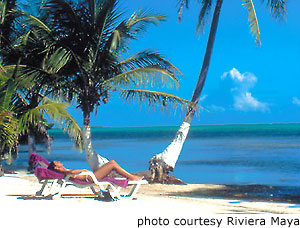 Our favorite spot was the next area -- the hammock park -- where we read, relaxed, and looked out over the sunbathers to the ocean, while alternating between dips back at the pool and walks on the beach. When the wind was right, it was not uncommon to see small sailboats, windsurfers, kayakers, and swimmers in the water, and a colorful air balloon or two in the sky.
Our favorite spot was the next area -- the hammock park -- where we read, relaxed, and looked out over the sunbathers to the ocean, while alternating between dips back at the pool and walks on the beach. When the wind was right, it was not uncommon to see small sailboats, windsurfers, kayakers, and swimmers in the water, and a colorful air balloon or two in the sky.
"I'm staying in the hammock park tomorrow," said our daughter, with a sigh and a smile, on the last day we planned a day trip. "When will I experience paradise again?"
Some of my favorite moments were in early evening when the sun quickly disappeared and darkness folded in. I would lie back in a lounge chair or hammock and read until there was not enough light on the page to continue. Then we would walk to the beach and watch the many shades of blue water turn dark, the sky change from blue to hues of orange, and purple, and then black.
I had expected our son and daughter to go into Playa del Carmen, the lively town next door with clubs, later on in the evening. They didn't. After dinner at one of the restaurants, we would take stroll through the park-like grounds of the hotel, go up to Mexico Street, the local shopping mall, or play card games in the Cuban café, actually a long two-story hall with a balcony that was an extension of the hotel lobby. The sounds of live music wafted up to us from the courtyard. When we could stay awake, we often attended the international music and dance shows that began at ten.
Now, I think of sensual memories, the hum of voices at breakfast, the mixture of conversations and wind at the beach, the feel of water on the beach and in the rivers, and the sense of awe at the way ancient and modern life in Mexico meld together. I want to return soon.
IF YOU GO:
The following websites provide much more information than could be included in the above article: http://www.rivieramaya.com,http:www.riu.com

